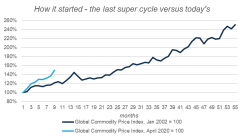By Gregor Spilker, CME Group
AT A GLANCE
- A weakened U.S. dollar, zero interest rates and pent up demand may be contributing to the fourth supercycle in a century
- Governments and private companies are increasingly pledging carbon reduction measures, heightening demand for certain metals
What was the Last Supercycle About?
The last supercycle could be summarized in a word: BRIC. Brazil, Russia, India, and China represented 2.6 billion people in 2000, or about 40% of world population. The idea was that the BRIC countries were on a path of rapid industrialization, which would require an unprecedented amount of raw materials, food and energy commodities. The cycle continued for more than 10 years, starting around the turn of the millennium and lasting well into the 2010s. The commodities boom began showing signs of slowing when the great financial crisis and the subsequent Euro crisis roiled markets in 2008 and 2011. It finally came to a halt when the Chinese economy cooled off in 2015.
What Speaks for a Supercycle Now?
The last supercycle was supported by a steadily eroding U.S. dollar. The currency had been on a depreciating path since the bursting of the dot-com bubble in 2001. It touched record low levels just as oil prices hit all-time highs in the summer of 2008. Since then, the U.S. dollar had been appreciating until the onset of Covid-19 in March 2020.
Why is it now weakening? The Federal Reserve has joined other central banks in the zero-interest rate policy (“ZIRP”) club as it has pulled all its levers to support the U.S. economy. Mechanically, a weak dollar often feeds into higher commodity prices. Raw materials are almost always priced in U.S. dollars, so a producer often needs to adjust prices upwards to offset the higher production costs in local currency. And on the demand side, a lower U.S. dollar means that, all else equal, commodities have become cheaper for an importing nation, leading to higher demand.
Since the great financial crisis, inflation has been most notable by its absence. This is despite many warnings that quantitative easing and zero-interest rates could lead to runaway prices. Central bankers have also signaled that higher-than-average inflation won’t necessarily result in an immediate rise in rates.
The idea of a supercycle is further supported by pent-up demand that could be unleashed once economies reopen. And many believe that governments won’t embrace the same austerity policies that they applied after the great financial crisis. Government spending is one key pillar supporting the supercycle hypothesis.
In the European Union, the fiscal stimulus package of 1.8 trillion Euros comes with a shade of green, with 30% dedicated to fighting climate change. In the U.S., the Biden administration is preparing a potential $3 trillion bill aimed at infrastructure projects and climate change.
The private sector is following suit, with car manufacturers in America and Europe promising to stop building vehicles with internal combustion engines by 2030 or 2035. It is likely that further commitments will be made in the months leading up to COP26, The United Nations’ annual Climate Change Conference. The event will be held in Glasgow, Scotland in November. Facing this increased demand, some bulls believe that supply may not be able to keep pace.
What Commodities Most Stand to Benefit?
A whole new market for metals such as cobalt, lithium, or nickel sulfate used in high-performance batteries is emerging to support the transition to electric vehicles (EVs).
The EV revolution applies to battery-focused materials but also to traditional metal products: aluminum is favored to build lower weight vehicles, and silver is widely used in photovoltaic installations. And of course, the move to electrification could provide higher demand for copper in the years to come.
As for oil markets, companies ranging from super majors to nimble shale producers have had to slash their exploration budgets, meaning that there are less new projects being developed. On the other hand, OPEC members have spare capacity to respond to stronger demand. Beyond oil, natural gas is a commodity that can act as a bridge fuel between coal and renewable energy. As coal plants are progressively taken off the grid in the U.S. and Europe, natural gas-powered generation could capture a larger share of the generation mix.
How Does This Cycle Compare to the Last One?
It could be said that of the four BRIC nations, only China was able to match investors’ high expectations from the last supercycle. From 2000 to 2020, the country increased its share of world GDP from 3.6% to 16.3%, according to World Bank. In the past decade, China has now carefully moved from an investment-driven economy to a consumption-driven model. 2020 commodity bulls believe that strong demand will not come only from emerging markets, but also from changes in Western economies.

The geopolitical backdrop to this cycle is also very different. At the start of the millennium, China had just joined the WTO, integrating the country into the world economy and further fueling its demand for commodities. Twenty years later, the U.S., China and other economies are navigating a less benign environment, where tariffs and quotas are used much more willingly.
Finally, it is also worth thinking about the implications of electrification and decarbonization at large scale – something that was not top of mind 20 years ago. If we are truly transitioning to an economy with a lower carbon intensity, this could, over the long-term, structurally reduce demand for fossil fuels. On the flip side, it would be dangerous to discount demand from emerging markets – Africa, Southeast Asia – where population growth alone could result in increasing appetite for oil.
Supercycle…. or Cyclical Upswing?
Genuine commodity supercycles do not come around often. Going back one century, only three or four bona fide supercycles have been identified. Each was tied to very transformational periods of economic development: the rapid industrialization of the United States (1910s), the re-industrialization of Germany and Japan following World War II (1950s), and of course, the growth in BRIC countries in the early 2000s. Many points mentioned above support the idea of a new cycle starting now, but it is still too early to say.
Read more articles like this at OpenMarkets






